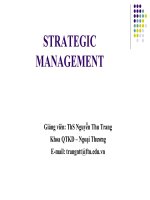Slide bài giảng môn quản trị chiến lược TS từ văn bình chương 6
Bạn đang xem bản rút gọn của tài liệu. Xem và tải ngay bản đầy đủ của tài liệu tại đây (1.75 MB, 57 trang )
Strategy
Analysis and
Choice
Chapter Six
Chapter Objectives
1. Describe a three-stage framework for
choosing among alternative strategies.
2. Explain how to develop a SWOT Matrix,
SPACE Matrix, BCG Matrix, IE Matrix, and
QSPM.
3. Identify important behavioral, political,
ethical, and social responsibility
considerations in strategy analysis and
choice.
Copyright ©2013 Pearson Education
6-2
Chapter Objectives
4. Discuss the role of intuition in strategic
analysis and choice.
5. Discuss the role of organizational culture
in strategic analysis and choice.
6. Discuss the role of a board of directors in
choosing among alternative strategies.
Copyright ©2013 Pearson Education
6-3
A Comprehensive StrategicManagement Model
Copyright ©2013 Pearson Education
6-4
The Process of Generating and
Selecting Strategies
A manageable set of the most attractive
alternative strategies must be developed
The advantages, disadvantages, tradeoffs, costs, and benefits of these
strategies should be determined
Copyright ©2013 Pearson Education
6-5
The Process of Generating and
Selecting Strategies
Identifying and evaluating alternative
strategies should involve many of the
managers and employees who earlier
assembled the organizational vision and
mission statements, performed the
external audit, and conducted the internal
audit.
Copyright ©2013 Pearson Education
6-6
The Process of Generating and
Selecting Strategies
Alternative strategies proposed by
participants should be considered and
discussed in a series of meetings.
Proposed strategies should be listed in
writing.
When all feasible strategies identified by
participants are given and understood, the
strategies should be ranked in order of
attractiveness.
Copyright ©2013 Pearson Education
6-7
The Strategy-Formulation
Analytical Framework
Copyright ©2013 Pearson Education
6-8
A Comprehensive StrategyFormulation Framework
Stage 1 - Input Stage
summarizes the basic input information
needed to formulate strategies
consists of the EFE Matrix, the IFE Matrix,
and the Competitive Profile Matrix (CPM)
Copyright ©2013 Pearson Education
6-9
A Comprehensive StrategyFormulation Framework
Stage 2 - Matching Stage
focuses on generating feasible alternative
strategies by aligning key external and internal
factors
techniques include the Strengths-WeaknessesOpportunities-Threats (SWOT) Matrix, the
Strategic Position and Action Evaluation
(SPACE) Matrix, the Boston Consulting Group
(BCG) Matrix, the Internal-External (IE) Matrix,
and the Grand Strategy Matrix
Copyright ©2013 Pearson Education
6-10
A Comprehensive StrategyFormulation Framework
Stage 3 - Decision Stage
involves the Quantitative Strategic Planning
Matrix (QSPM)
reveals the relative attractiveness of
alternative strategies and thus provides
objective basis for selecting specific
strategies
Copyright ©2013 Pearson Education
6-11
Matching Key External and Internal Factors
to Formulate Alternative Strategies
Copyright ©2013 Pearson Education
6-12
The Matching Stage
The Strengths-WeaknessesOpportunities-Threats (SWOT) Matrix
helps managers develop four types of
strategies:
SO (strengths-opportunities) Strategies
WO (weaknesses-opportunities) Strategies
ST (strengths-threats) Strategies
WT (weaknesses-threats) Strategies
Copyright ©2013 Pearson Education
6-13
The Matching Stage
SO Strategies
use a firm’s
internal strengths
to take advantage
of external
opportunities
Copyright ©2013 Pearson Education
WO Strategies
aim at improving
internal
weaknesses by
taking advantage
of external
opportunities
6-14
The Matching Stage
ST Strategies
use a firm’s
strengths to avoid
or reduce the
impact of external
threats
Copyright ©2013 Pearson Education
WT Strategies
defensive tactics
directed at
reducing internal
weakness and
avoiding external
threats
6-15
SWOT Matrix
1. List the firm’s key external opportunities
2. List the firm’s key external threats
3. List the firm’s key internal strengths
4. List the firm’s key internal weaknesses
5. Match internal strengths with external
opportunities
Copyright ©2013 Pearson Education
6-16
SWOT Matrix (cont.)
6. Match internal weaknesses with external
7.
8.
opportunities, and record the resultant WO
Strategies
Match internal strengths with external
threats, and record the resultant ST
Strategies
Match internal weaknesses with external
threats, and record the resultant WT
Strategies
Copyright ©2013 Pearson Education
6-17
A SWOT Matrix for a Retail
Computer Store
Copyright ©2013 Pearson Education
6-18
A SWOT Matrix for a Retail
Computer Store
Copyright ©2013 Pearson Education
6-19
The SPACE Matrix
Copyright ©2013 Pearson Education
6-20
The Strategic Position and Action
Evaluation (SPACE) Matrix
Strategic Position and Action
Evaluation (SPACE) Matrix
four-quadrant framework indicates whether
aggressive, conservative, defensive, or
competitive strategies are most appropriate
for a given organization
Copyright ©2013 Pearson Education
6-21
The Strategic Position and Action
Evaluation (SPACE) Matrix
Two internal dimensions (financial
position [FP] and competitive position
[CP])
Two external dimensions (stability
position [SP] and industry position [IP])
Most important determinants of an
organization’s overall strategic position
Copyright ©2013 Pearson Education
6-22
Factors That Make Up the
SPACE Matrix Axes
Copyright ©2013 Pearson Education
6-23
Steps to Develop a SPACE Matrix
1. Select a set of variables to define
financial position (FP), competitive
position (CP), stability position (SP), and
industry position (IP)
Copyright ©2013 Pearson Education
6-24
Steps to Develop a SPACE Matrix
2. Assign a numerical value ranging from +1
(worst) to +7 (best) to each of the
variables that make up the FP and IP
dimensions. Assign a numerical value
ranging from –1 (best) to –7 (worst) to
each of the variables that make up the
SP and CP dimensions
Copyright ©2013 Pearson Education
6-25









